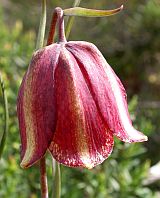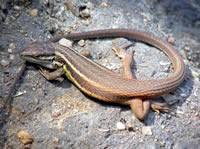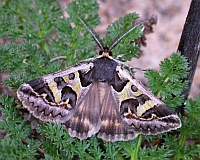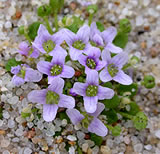 |
The Tróia peninsula's unique sand-dune flora and fauna
Perhaps the best way to start exploring the Sado estuary is to take the small car ferry
across the river mouth from Setúbal to the northern tip of the Tróia peninsula (about 20 minutes).
In good weather you can hope to see bottle-nosed dolphins (a population of around 30 individuals
inhabits these waters), with black-necked grebe (50-100 birds, representing the bulk of Portugal's
 Fritillaria lusitanica
© Teresa Farinowintering population), red-breasted merganser (maximum 350 individuals), common scoter,
Sandwich tern and razorbill occurring in winter.
Fritillaria lusitanica
© Teresa Farinowintering population), red-breasted merganser (maximum 350 individuals), common scoter,
Sandwich tern and razorbill occurring in winter.
From Tróia, the N-253-1 runs south along the sandspit to the village of Comporta.
After a few kilometres, a track off to the left leads to the Roman ruins of Cetóbriga
(from which present-day Setúbal derives its name) and a tranquil tidal inlet on the lee
shore known as the Caldeira de Tróia, which attracts many passage and wintering waterbirds
including greater flamingo, spoonbill and Mediterranean and great black-backed gulls, the
latter rare in Portugal. The coastal sands adjacent to the inlet are clothed with stone
and maritime pines, acacias and eucalypts, with an understorey of Osyris lanceolata, white
broom, lentisc and the yellow-flowered Halimium calycinum and H. halimifolium, with more open
 Large Psammodromus
Large Psammodromus
Psammodromus algirus
© John Muddeman
areas holding typical psammophiles such as the stonecrop Sedum sediforme, Sodom's apple and several
Portuguese endemics: the diminutive pink-flowered crucifer Jonopsidium acaule, in flower from January
to March, Thymus capitellatus and the lavender-cotton Santolina impressa. This is also a good place
to track down the snakeshead Fritillaria lusitanica.
The mid-sector of the spit has been declared a botanical reserve, on account of its well-preserved dune flora.
Primary dunes here are clothed with sea knotgrass, southern birdsfoot-trefoil, sea spurge, the succulent-leaved
Iberian endemic Thymus carnosus, the umbellifer known as pseudorlaya, coastal crucianella and cottonweed, while
the older, stabilised dunes boast a more diverse flora, including sand stock, sea-holly, spiny thrift and sea daffodil,
growing amid clumps of the heather-like Corema album and the fleshy figwort Scrophularia frutescens, both of which are
 Cerocala scapulosa
© Teresa Farino
Afro-Iberian endemics. Among Tróia's lepidoptera, look out for an abundance of the smart day-flying moth - rather
like a Mother Shipton - called Cerocala scapulosa in March, while spring butterflies include Swallowtail, Clouded Yellow,
Lang's Short-tailed and Common Blues, Spanish Brown Argus and Small Copper.. The commonest reptile here is
undoubtedly the robust, extremely long-tailed lizard known as the large psammodromus, but spiny-footed lizards are also present.
Cerocala scapulosa
© Teresa Farino
Afro-Iberian endemics. Among Tróia's lepidoptera, look out for an abundance of the smart day-flying moth - rather
like a Mother Shipton - called Cerocala scapulosa in March, while spring butterflies include Swallowtail, Clouded Yellow,
Lang's Short-tailed and Common Blues, Spanish Brown Argus and Small Copper.. The commonest reptile here is
undoubtedly the robust, extremely long-tailed lizard known as the large psammodromus, but spiny-footed lizards are also present.
Fossil dunes in the centre of the spit support a scrub community dominated by the dune race of Phoenician juniper
 Jonopsidium acaule
© John Muddeman
(turbinata), sage-leaved cistus (here parasitised waxy yellow clumps of Cytinus hypocistis), the gorse-like Stauracanthus
genistoides, a Portuguese endemic subspecies of French lavender (luisieri) and Santolina impressa. Open sands are studded
with the catchfly Silene littorea, shrubby pimpernel (var. trojana) and the glorious blue-flowers of Anchusa calcarea
in spring, while wetter depressions harbour a colourful assemblage of the yellow-flowered restharrow Ononis ramosissima
and the snapdragon Antirrhinum majus ssp. linkianum, emerging from a carpet of grey hair-grass. Here too grow Dianthus
broteri and the toadflaxes Linaria ficalhoana and L. bipunctata (var. welwitschiana), all of which are unique to Iberia,
plus the Portuguese endemic thrift Armeria rouyana. Dartford and Sardinian warblers abound in the most densely vegetated
areas, with Thekla lark in open habitats.
Jonopsidium acaule
© John Muddeman
(turbinata), sage-leaved cistus (here parasitised waxy yellow clumps of Cytinus hypocistis), the gorse-like Stauracanthus
genistoides, a Portuguese endemic subspecies of French lavender (luisieri) and Santolina impressa. Open sands are studded
with the catchfly Silene littorea, shrubby pimpernel (var. trojana) and the glorious blue-flowers of Anchusa calcarea
in spring, while wetter depressions harbour a colourful assemblage of the yellow-flowered restharrow Ononis ramosissima
and the snapdragon Antirrhinum majus ssp. linkianum, emerging from a carpet of grey hair-grass. Here too grow Dianthus
broteri and the toadflaxes Linaria ficalhoana and L. bipunctata (var. welwitschiana), all of which are unique to Iberia,
plus the Portuguese endemic thrift Armeria rouyana. Dartford and Sardinian warblers abound in the most densely vegetated
areas, with Thekla lark in open habitats.
|